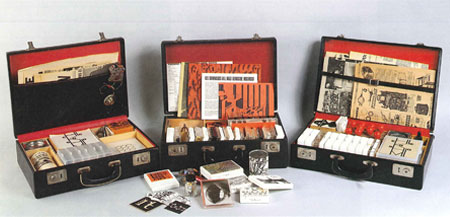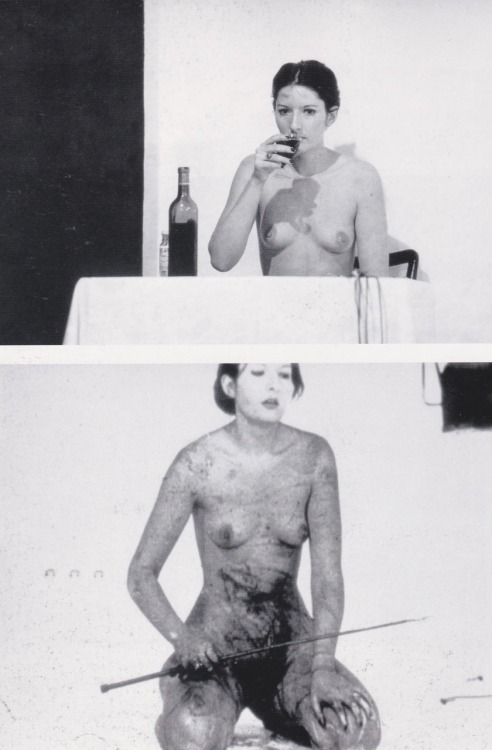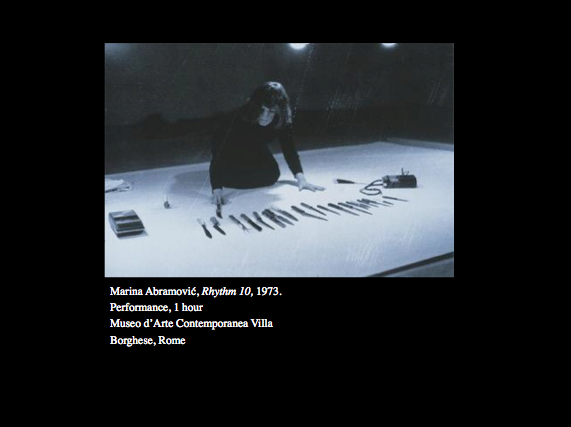Below is a list of the top ten most relevant print and online resources that I have found in researching the life and performance art of Marina Abramović, as well as about performance and body art in general:
- Abramović, Marina, Biesenbach, Klaus, and Museum of Modern Art. Marina Abramović: The Artist Is Present. New York: Museum of Modern Art, 2010.
This exhibition catalogue was published in conjunction with Marina Abramović’s performance The Artist is Present, held at the Museum of Modern Art in 2010. The catalogue includes essays by Chief Curator of Media and Performance Art, Klaus Biesenbach, as well as four other scholars who analyze Marina Abramović’s performances through the themes of time, duration, and risk. The book covers over forty years of Abramović’s career, from her early sound environments and installations, to her current body art performances.
- Jones, Amelia.Body Art/performing the Subject. Minneapolis: University of Minnesota Press, 1998.
This book by Amelia Jones is a seminal text about performance and body art from the 1960s and 1970s and their influence on the body art of the present. In her discussion, Jones applies feminism, queer theory, psychoanalysis, philosophy, and literary theory in order to provide a diverse perspective to the history, influences and goals of body art performances from the 1950s onward.
- Dezeuze, Anna.The ‘do-it-yourself’ Artwork: Participation from Fluxus to New Media. Rethinking Art’s Histories. Manchester, UK: New York: Manchester University Press; Distributed in the United States by Palgrave Macmillan, 2010.
This anthology by Anna Dezeuze emphasizes the crucial role of the spectator through a discussion of various practices including happenings, installations, and performances from the 1950s to today. These essays provide a thorough historical background to the development of performance art from the 1950s to present, while also discussing theory on viewership and identity. Frazer Ward’s essay “Marina Abramović: approaching zero,” and Anna Dezeuze’s essay “Play, Ritual, and Politics: transitional artworks in the 1960s,” are particularly useful in their discusses of the themes of Abramović’s performance art, as well as work of other artists in the 1960s and 1970s.
- Westcott, James.When Marina Abramović Dies: A Biography. Cambridge, Mass.: MIT Press, 2010.
This biographical history of Marina Abramović thoroughly covers Abramović’s life from her early beginnings in Yugoslavia; to her increasing success as one of the contemporary art world’s most influential performance artists. Westcott discusses not only Abramović’s seminal performance works, but also thoroughly covers Abramović’s influential beginnings in Yugoslavia from 1946 to 1975, with particular interest in her tremulous relationship with her parents.
- Crow, Thomas (1996).The Rise of the Sixties: American and European art in the era of dissent(Perspectives (Harry N. Abrams, Inc.)). New York, N.Y.: Harry N. Abrams.
This book by Thomas Crow provides an extensive overview of the art and major social and political movements of the 1960s and 1970s both in the United States and in Europe. Crow leads the reader along a timeline following formative events and movements of the period, and neatly parallels this history with artists and artworks whose evolutions reflect their historical context.
- Thurman, Judith. “Walking Through Walls: Marina Abramović’s Performance Art.”The New Yorker. March 8, 2010. http://www.newyorker.com/magazine/2010/03/08/walking-through-walls.
This fascinating article by Judith Thurman was written in preparation for Abramović’s then upcoming MoMA retrospective, The Artist is Present (2010). However, this article not only discusses the upcoming exhibition, but provides an in-depth account of Abramović’s background (both her personal history and performance history), starting with her upbringing in former-Yugoslavia under strict Partisan war-hero parents, and moving forward to give a detailed overview of Abramović major performances from 1973 to present (2010).
- Reckitt, Helena, and Phelan, Peggy. Art and Feminism. Themes and Movements. London; New York, NY: Phaidon, 2001.
This book is a monumental resource for anyone interested in learning not just about Marina Abramović, but also about over 150 other major female artists. Art and Feminism is organized thematically, and includes images, brief essays and interviews, as well as an entire section dedicated to social, political and theoretical essays by a variety of top feminist scholars.
- Jones, A. (1997). “Presence” in Absentia: Experiencing Performance as Documentation.Art Journal, 56(4), 11-18.
This article by art historian Amelia Jones, focuses on the issue of ephemerality in performance art, and its subsequent reliance on documentation. Jones, in her overview of performance art from the 1960s to present, includes detailed case studies of major performance and body artists including Marina Abramović, Carolee Schneemann, and Yayoi Kusama, in which she analyzes their performances in relationship to issues of agency, objectivity, presence, and documentation.
- Goldberg, RoseLee.Performance: Live Art since 1960. New York: Harry N. Abrams Publishers, 1998.
In this survey of performance art from the 1960s to present (1998), RoseLee Goldberg provides an in-depth analysis of major movements and artists definitive of performance art. Thematic sections cover topics relevant to the work of Marina Abramović (who is discussed in detail, however, is not the sole focus of the book) such as body, politics, theater, feminism, and multiculturalism, and Goldberg pairs her discussion of these themes with fantastic photographs that illustrate her case studies.
- Abramović, Marina, Thompson, Chris, and Weslien, Katarina. “Pure Raw: Performance, Pedagogy, and (Re)presentation.”PAJ: A Journal of Performance and Art 28, no. 1 (2006): 29-50.
In this extensive interview with Abramović, Chris Thompson and Katarina Weslien begin by providing a concise but detailed biography of Abramović, followed by an in-depth discussion with the artist in which they discuss her attraction to performance as a living medium, the use of her own body, the element of risk and chance, as well as the defining element of duration recurring in her performance works. The dialogue is grounded in examples from a multitude of Abramović’s performance works from the 1970s to today.









































